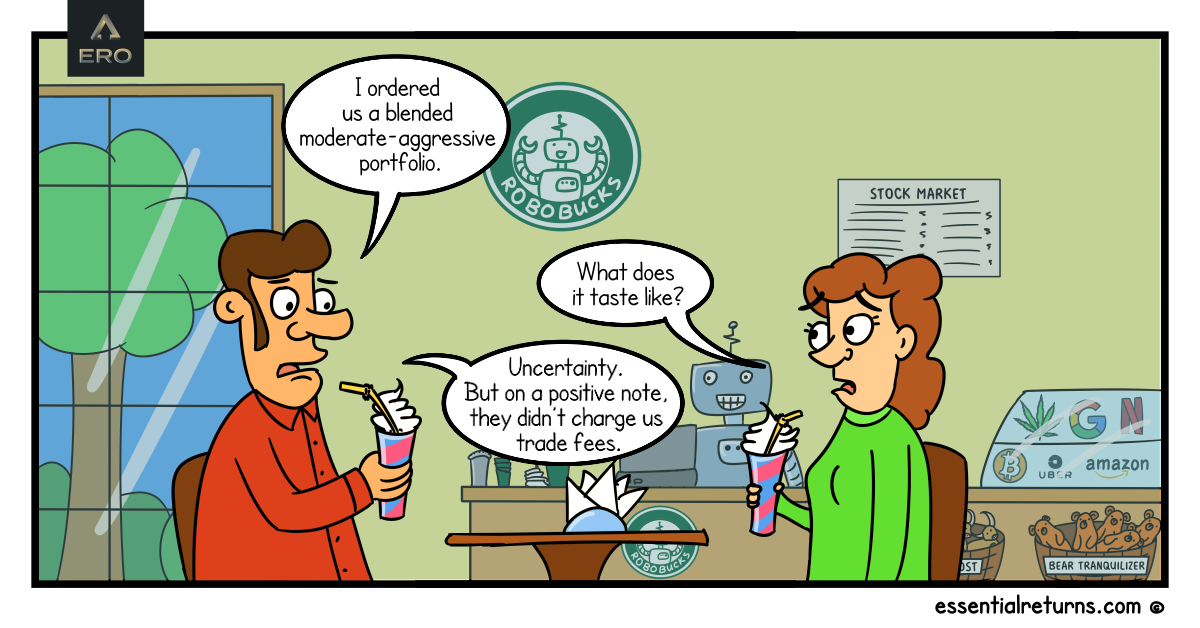
How the Post-Modern Portfolio Methodology
Outperforms Modern Portfolio Theory and it’s Uncertainties
The foundation of the PMPT Methodology is the Essential Return Objective (ERO).
It is the return that links the investor’s assets to the goal they are attempting to achieve.
The Essential Return Objective is used to analyze managers, measure performance and construct portfolios that benefit investors and advisors.
The Essential Return Objective is the road the investor’s assets travel upon to reach their ultimate destination.
Each investor has different financial requirements, timelines, and goals.
Therefore each deserves an investment strategy tailored to their unique lifestyle.
Sophisticated investors have no tolerance for one-size-fits-all asset allocation strategies that are based on outdated theories of risk.
With the advancements in technology, it’s now possible to efficiently construct portfolios suitable for each investor’s goals and lifestyle.

* The goal is to replace 70% of current income at retirement.
Managing Investor Expectations
The Essential Return Objective has little relationship to mean/variance.
In Modern Portfolio Theory (MPT) Risk in the mean/ variance framework is measured by Standard Deviation.
Reward is measured by an agreed upon benchmark that doesn’t necessarily link the investor’s assets to their goal.
Standard Deviation in the mean-variance framework is a risk measurement statistic that enables the investor to assess volatility.
Standard Deviation assumes the investor is just as happy with returns below the benchmark as they are with returns above the benchmark. Are they really?
Standard Deviation doesn’t provide any indication of the magnitude that future returns will exceed or fall below the benchmark.
Standard Deviation has no relationship to risk.
Real Risk is failing to achieve the goal of the investor.
In most cases the benchmark is a market index.
However, the objective is not to beat the market but to accomplish the client’s goal.
Outperforming the market and underperforming the Essential Return Objective doesn’t get the investor any closer to accomplishing their goal.
Essential Return Objective is the benchmark that all performances (passive and active) should be measured against.
PMPT Approach to Risk Assessment
The PMPT Methodology utilizes different risk measurement statistics that are more precise and informative.
The risk measurement statistics are referred to as Upside Potential, Downside Risk and ERO- Alpha.
They are more informative than Standard Deviation and Risk Adjusted Return Ratios because they provide magnitude, frequency and whether past returns met or exceeded the Essential Return Objective.
They are more precise because they rely on monthly data and managers are penalized more severely for their downside performance than they are given credit for exceeding the Essential Return Objective.
Below is one of the formulas the PMPT Methodology uses to assess the risk of achieving the Essential Return Objective.
The numerator represents upside while the denominator represents downside performance.
Notice that the returns in the denominator are squared to penalize the managers more severely for falling below the Essential Return Objective.
We refer to this statistic as the Upside Potential Ratio.
Upside Potential Ratio = (Return- Essential Return Objective Probability/
[(Return- Essential Return Objective 2 probability] 1/2
In the example above both Funds exceed the Essential Return Objective 70% of the time; however Fund 2 has a better chance (upside potential) of exceeding the Essential Return Objective by a greater percentage, 2.0% vs. 1.1%.
ERO Alpha
Modern Portfolio Theory (MPT) is based on the assumption that all assets should be priced in equilibrium so that on a risk adjusted basis all returns are equal.
If the goal is to beat the market and all assets are priced in equilibrium then one has no hope of beating the market.
However the market in MPT is defined as having the ability to invest proportionally in all the assets in the world.
In addition MPT assumes that investors base their decisions in a mean/variance framework and uncertainty is a bell shaped curve; that low returns are just as likely as high returns (symmetric).
However we know that uncertainty is not symmetric, since all you can do is lose all your money, distributions cannot go to minus infinity. (Positively skewed).
Peter Fishburn’s path-breaking work on deviations below a Target Return led to development of downside risk and the Essential Return Objective.
The approach to identifying money managers with skill incorporates risk-adjusted methodologies that utilize both Bill Sharpe’s returns-based style analysis and Daniel Kahneman’s behavioral science approach to investor preferences.
It is widely accepted that no manager is pure a particular style and in order to determine if the manager adds value to a diversified portfolio a manager’s style-blended return needs to be determined and then measured against a similar style blended benchmark.
However this requires to identify benchmarks that were style pure.
If the benchmarks aren’t style pure then all the analytics based on those benchmarks would be useless.
Using the groundbreaking work of the above noted academics Dr. Frank Sortino has developed a more conservative approach in analyzing a manager’s past performance and determining whether a manager is skillful based not on an ill-defined benchmark but on the investor’s ERO.
Sortino measures the manager’s style blended performance against a Target Return (ERO) and focuses on the returns (downside) below the ERO.
In addition Sortino will also measure the downside performance of a similar style blended benchmark.
Sortino takes the downside statistics’ for both the manager and the benchmark and divides the manager’s style blended downside deviation by the style blended benchmark.
Benchmark’s downside deviation and comes up with a statistic referred to as a Style Beta.
The Style Beta works similar to the Beta that all are familiar with, in that any number over 1.00 a manager is taking more downside risk and anything below less.
Sortino takes the Style Beta and multiplies the downside risk (variance) of the manager’s style blended benchmark providing us with a Style Adjusted Downside (SAD) statistic which allows us to compare apples with apples.
This calculation is multiplied by a risk aversion number (we use 3 based on Kahneman’s research indicating that investors need 3 units of return for every unit of risk they take) allowing us to adjust the performance of the money manager (ERO Alpha).
Once the performance of the manager is adjusted we subtract the managers’ style benchmark return from the ERO Alpha of the manager to identify the added value the manager contributes to the portfolio, which is referred to as the ERO Alpha.
If there is no added value then the Style Benchmark is used.
Below is a simple example:
Manager’s return for the period analyzed = 35% (R)
Downside variance of the managers style benchmark= 0.0231 (DVAR style)
Investor risk aversion = 3
Downside risk of money manager divided by downside risk of the style benchmark =1.25(Style Beta)
Manager is taking 25% more downside risk.
ERO Alpha = Return-Aversion [style beta (downside variance of the style benchmark)]
= .35- 3[1.25(0.0231)
= .35- 0.086
= 26.34%
If the return for the manager’s style benchmark was 20% then the ERO Alpha for the manager would be:
26.34% – 20.00%= 6.34%
The manager adds value and should be considered for inclusion into the portfolio.
Sortino uses both the upside potential ratio and ERO Alpha to determine whether a manager should be considered for the portfolio.
Asset Allocation Strategy
Another important feature of using the Essential Return Objective is its role in developing an Asset Allocation Strategy.
Previously it was noted that all managers’ performances must be measured against the Essential Return Objective to determine the risk/return characteristics of the money manager.
However, that will not provide us the information needed to determine if the Asset Allocation Strategy created will be the one delivered.
Asset Allocation Strategies revolve around both Asset and Style Mix policies.
It is extremely important to understand that no active manager is pure a particular style.
If this fact is not recognized the Asset Allocation Strategy created is not the one that will be delivered.
In the illustration below only 25% of the required 100% filled the mid-growth bucket.

To solve for this problem and to determine if the active manager adds value to the asset allocation strategy it is necessary to identify the style blended return of the money manager and measure those returns against a similar passive style blended portfolio.
We suggest the Morningstar’s nine style indices.
They are the purest form of Value, Core, and Growth for Large, Mid, and Small equities.
Simply put if the manager outperforms (we refer to this as ERO Alpha) their similarly constructed passive style blended benchmarks then they are considered for inclusion into the portfolio, if not the passive alternative is used.
Data
When forecasting money managers’ future returns and the uncertainty that it entails more data is better than less.
Unfortunately managers’ performances are categorized typically into 3, 5 and 10 year quarterly results, leaving the consultant with a limited number of data points to examine.
In addition the returns are linear so that both good and poor performances fall off after a period of time.
This approach increases the risk of not capturing poor or good performance and could eventually lead to bad manager selection.
Sortino has incorporated a more detailed and informative way to look at past performance. A technique referred to as Bootstrapping proposed by Efron and Tibshirani allows an analyst to look at what could have happened instead of what did.
For example the graph below demonstrates the effectiveness of bootstrapping:
The graph shows 4 years of monthly returns for a money manager.
Typically a consultant will only have 5 years of quarterly returns, possibly more if rolling periods are used and they will be linear.
If we assume that returns are uncorrelated the consultant is going to believe that the worst performing year for this manager was a positive +30% and will assume that there is very little downside risk.
However what if we assumed that next year’s return is made by compounding a random sample of 12 of the monthly returns from the above graph.
Our first random draw might be 4% drawn from the sixth month of the fourth year.
The first draw is replaced and a second return is randomly selected, in this case -6%.
Notice this same return is again selected for the last month of one year that could have happen.
We repeat this process 2000 times and we now have more data points and possible uncorrelated performance outcomes than using the standard approach.
As the graph demonstrated, a -35% year could have happened.
The point of all this is now we have more downside deviations and upside potential data to work with when attempting to determine the Upside Potential Ratio and ERO of the money manager.
In addition each of these measurements will be described with a probability distribution giving the consultant a more intuitive understanding of the money manager’s potential future performance.
We believe that using this approach reduces the risk of poor manager selection.
A world of uncertainty
The information presented in this primer is for illustration purposes only and as a way to simplify a complex subject.
The main point we would like to emphasize is the conservative approach that is used to analyze past performance in order to predict future results in a world of uncertainty.
Every calculation performed is related to protecting the investor on the downside.
From style beta, downside deviation, risk aversion and ERO Alpha every statistic is calculated by penalizing the manager more severely for performing below than giving them credit for meeting or exceeding the Essential Return Objective.
The culmination of over 40 years of work by Dr. Sortino and the work of highly acclaimed academics and Noble Prize winners has brought us to a new paradigm of investing.
One that focuses on the essential return needed to accomplish an investor’s goal while at the same time providing the downside protection every investor seeks through scientific portfolio navigation.
To have a conversation about how ERO can benefit your goals, contact us.




